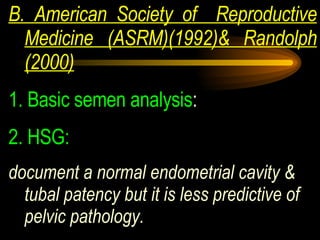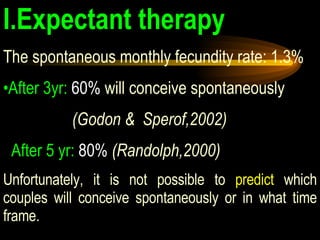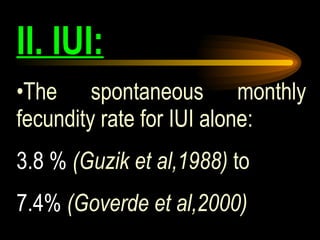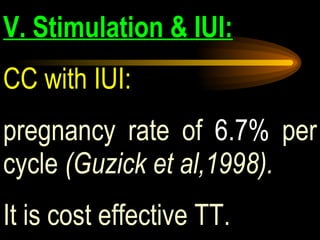Unexplained Infertility
- 1. unexplained infertility Prof. Aboubakr Elnashar Benha University Hospital, EGYPT E-mail: elnashar53@hotmail.com Update on management of
- 2. Definition Inability to conceive after one year with routine (standard, basic) investigations of infertility showing no abnormality. (RCOG guidelines,1998; Randolph,2000)
- 3. Prevalence Depend on: Evaluation protocol Referral pattern, Interpretation of diagnostic studies 10-20% (Balen,2003) Decreasing: (Collins & Crosignani,1992)
- 5. Effect of unexplained infertility on psychosexual function Depression or history of depression were significantly higher in women with unexplained infertility than in the control group (Meller et al, 2002) Unexplained infertility: prolonged & mutual agony & sexual dysfunction . Recognition of the cause of infertility: acceptance of childlessness & return to normal sexual behavior.
- 6. CAUSES It is possible to draw long list of putative & subtle causes of infertility, Many are uncertain Many have been found in couples of normal fertility. Few are actually treatable (Balen,2003) .
- 7. I. Ovarian & endocrine factors : 1. Abnormal follicle growth 2. Lutenized unruptured follicle 3. Hypersecretion of LH. 4. Hypersecretion of prolactin in the presence of ovulation 5. Reduced growth hormone secretion/sensitivity 6. Cytologic abnormalities of in oocytes. 7. Genetic abnormalities in oocytes 8. Antibodies to zona pellucida Putative Subtle Uncertain Found in fertile couples
- 8. II. Peritoneal factors. 1. Altered macrophage & immune activities. 2. Mild endometriosis 3. Antichlamydial antibodies III.Tubal factors 1. Abnormal peristalsis or cilial activity 2. Altered macrophage & immune activity Putative Subtle Uncertain Found in fertile couples
- 9. IV. Endometrial factors 1. Abnormal secretion of endometrial proteins 2. Abnomal integrin/adhesion molecule 3. Abnormal T cell & natural killer cell activity. 4. Secretion of embyotoxic factors 5. Abnormalities in uterine perfusion V. Cervical factors 1. Altered cervical mucus 2. Increased cell-mediated immunity Putative Subtle Uncertain Found in fertile couples
- 10. VI. Male factors 1. Reduction in motility, acrosome reaction, oocyte binding & zona penetration 2. Ultrastructural abnormalities of head abnormalities VII. Embryological factors 1. Poor quality embryo 2. Reduced progression to blastocyst in vitro 3. Abnormal chromosomal complement- increased miscarriage rate Putative Subtle Uncertain Found in fertile couples
- 11. DIAGNOSIS UI is a diagnosis of exclusion To establish the diagnosis of UI the clinician should consider the following (Moghissi et al,2000) Was the infertility evaluation 1. complete? 2. performed correctly? 3.interpreted appropriately?
- 12. European Society of Human Reproduction & Embryology (ESHRE) (2000) Infertility testing should be classified into 3 groups depending on correlation with pregnancy rates I. Tests that have an established association with pregnancy: Conventional semen analysis Tubal patency tests, Tests of ovulation
- 13. II. Tests that are not consistently associated with pregnancy: Post-coital test, Antisperm antibody tests Zona-free hamster egg penetration test III. Tests that have no association with pregnancy: Endometrial biopsy Varicocele assessment Chlamydia testing
- 14. STANDARD (BASIC,Routine) INVESTIGATIONS A. Balen (2003),RCOG Guidelines (1998), Cooke (1999),National Guideline Clearinghouse (2000) : 1. Basic semen analysis. 2. HSG 3. Mid luteal serum progestrone. There is no value in measuring thyroid or prolactin in women with regular menstrual cycle, in the absence of galactorrhea or symptoms of thyroid disease (RCOG guidelines,1998).
- 15. B. American Society of Reproductive Medicine (ASRM)(1992)& Randolph (2000) 1. Basic semen analysis : 2. HSG: document a normal endometrial cavity & tubal patency but it is less predictive of pelvic pathology.
- 16. 3. Assessment of occurrence & adequacy of ovulation: Mid-luteal srerum progesterone: less invasive way to assess luteal function, controversy persists regarding the lower limit of normal.
- 17. b. LH surge in urine: sensitive, relatively inexpensive, pinpoint the day of ovulation & has reduced the uncertainty in interpretation of progesterone levels by better-identifying the time of peak progestrone secretion at which to obtain serum
- 18. 4 . Laparoscopy: Indicated in presence of an abnormal HSG or history or symptoms suggestive of pelvic disease. In women with normal HSG or without history suggestive of tubal disease, The probability of clinically relevant tubal disease or endometriosis is very low & laparoscopy is not justified or cost effective (Fatum et al, 2002).
- 19. Laparoscopy may reveal minimal or mild endometriosis or peritubal adhesions . In these cases either surgery or medical treatment has not been proven to improve fecunditity. With the current success rates of ART& the relatively low contribution of diagnostic laparoscopy to the decision making of treating patients with normal HSG, laparoscopy should be omitted in couples with unexplained infertility. These patients should be treated as UI (by 3 cycles of combined gonadotropins & IUI & if unsuccessful ART)
- 20. Treatment What is the treatment? Once the well-known & obvious causes of infertility have been excluded , the treatment of couples with unexplained infertility is the same (Balen,2003) . In UI: the disease is not defined, so treatment is empirical ( Soules , 2000 )
- 21. What aim of the treatment?: to increase the monthly pregnancy rate above the natural rate of 1.5-3% How?: improve gamete quality increase gamete number facilitate gamete interaction.
- 22. When?: depend on 1.duration of infertility 2. woman , s age & 3.the previous pregnancy history
- 23. Combined pregnancy rates per cycle (Guzik et al, 1998) No treatment 1.3% IUI 3.8% CC 5.6% CC with IUI 8.3% HMG 7.7% HMG with IUI 17.1% IVF/ICSI 20.7% Alternative therapies
- 24. I.Expectant therapy The spontaneous monthly fecundity rate: 1.3% After 3yr: 60% will conceive spontaneously (Godon & Sperof,2002) After 5 yr: 80% (Randolph,2000) Unfortunately, it is not possible to predict which couples will conceive spontaneously or in what time frame.
- 25. Expectant therapy for 6-12 mo.: < 35yr. or <3 yr. of infertility, Aggressive therapy: > 35yr. or >3 yr. of infertility (Soules,2000).
- 26. A nonhomogenous hyperechogenic sonographic endometrial echo pattern predicts lower fertility potential in women who are not receiving follicle maturing drugs in unexplained infertility (Check et al, 2003)
- 27. II. IUI: The spontaneous monthly fecundity rate for IUI alone: 3.8 % (Guzik et al,1988) to 7.4% (Goverde et al,2000)
- 29. III. Clomiphene citrate: CC enhances fertility by: 1.Correcting subtle defect in ovarian function-either follicular development or luteal phase defect 2. Increasing the number of follicles that develop & consequently oocyte that are released (Balen,2003).
- 30. Pregnancy rate for cycle: 5.6% Although small increase in fecundity, the low cost & ease of administration, CC is a sensible first choice treatment (Cochrane,2001) .
- 31. IV. Gonadotropins: Per cycle pregnancy rate of 7.7% for gonadotrpin alone (Guzick et al,1998). Oral ovulation induction agents had significantly reduced odds of pregnancy per women compared to injectable ovulation induction agents (Athaullah et al, 2002, Chochrane review)
- 32. V. Stimulation & IUI: CC with IUI: pregnancy rate of 6.7% per cycle (Guzick et al,1998). It is cost effective TT.
- 33. Gonadotropins with IUI: 18% per cycle pregnancy rate (Guzick et al,1998). The cycle fecundity in the first 3 trials of COH & IUI was higher than in cycles 4-6 COH & IUI should be limited to 3 trials (Aboulghar et al,2001) .
- 34. VI. IVF/ICSI: Rationales: 1.To increase the number & quality of oocytes available for fertilization, 2. To facilitate the sperm-oocyte interaction & enhance fertilization, 3. To document the occurrence of fertilization , & to evaluate embryo quality (Randolph,2000) . Cycle fecundity rate: 25.7% (ESHRE).
- 35. 1. IVF Vs Expectant management: There was no significant difference in clinical pregnancy rate between IVF & expectant management (Pandian et al,2003, Cochrane review).
- 36. 2. IVF Vs IUI There was no evidence of difference in live birth rates between IVF & IUI either without or with ovulation stimulation. The effectiveness of IVF in unexplained infertility remains unproven (Pandian et al,2003, Cochrane review). The initial treatment of UI should be IUI as opposed to IVF (Homburg,2003)
- 37. 3.IVF Vs ICSI: Complete fertilization failure was higher in conventional IVF (34.3%) than ICSI (10.3%) cycles in unexplained infertility (Jaroudi et al,2003). ICSI should be the first option for in vitro fertilization in unexplained infertility (Sertac et al,2000). ICSI should be the first line therapy for women over 35 yrs (Balen,2003)
- 39. VII. Alternative therapies: 1 . Bromcriptine is not effective (Cochrane,2001) . 2. Danazol is not effective (Cochrane,2001) . 3. Fallopian tube sperm perfusion: had insufficient evidence to support use in pooled analysis (Cochrane,2001)
- 40. 4. Oil soluble HSG: is associated with increased cycle fecundity when compared with water soluble (Cochrane,2001). There was a statistically significantly higher pregnancy rates in couples with UI randomized to a single tubal flush with lipiodol compared with no treatment (Nugnet et al,2002)
- 41. 5. Letrozole: an oral, reversible, no-steroidal aromatase inhibitor. Dose: 2.5 mg/d from day 3-7 Mechanism of action: 1. Release of the estrogen negative feedback, increase GnTR, stimulate ovarian follicle development 2. Increase sensitivity of follicles to FSH.
- 42. Advantages of letrozole over CC: Because of the short half life (45h) & absence of ER depletion No effect on the endometrial thickness or cervical mucous
- 43. Letrozole is effective for increasing follicle recruitment in UI (Mitwally & Casper,2000) Letrozole can replace CC in patients with UI undergoing ovulation induction & IUI (Sammour,2001). Letrozole improved response to FSH evidenced by lower FSH dose & higher number of mature follicles in women with UI (Mitwally & Casper, 2003)
- 44. PROGRESSIVE TREATMENT REGIMEN (Soules,2000). Treatment should follow an orderly progression of intensity & expense The pace & intensity of treatment depend on couple,s desires, anxiety & cost. Some wishing to proceed swiftly to ART & others wanting to avoid ART for as long as possible
- 45. . D oxycyclin for both partners (effective for most cases of pyospermia, cervicitis, &/or endometritis) 1. IUI 3 cycles (simple & would treat an undiagnosed cervical or male factor) 2. Clomifene citrate + IUI for 3 cycles. 3. Gonadotrophins + IUI for 2 cycles. 4. ICSI 75% of couples with UI will conceive after this treatment.
- 46. Effect of unexplained infertility on obstetric outcome: Women with unexplained infertility are at higher risk of obstetric complications which persist even after adjusting for age, parity, & fertility treatment (Pandian et al, 2001) . The reasons are unclear.
- 47. They had higher incidence of pre-eclampsia, abrutio placentae, preterm labour, emergency cesarean section, & induction of labour in comparison with general population.
- 48. Conclusions 1. Incidence of UI is decreasing 2. Many causes of UI are uncertain & few of which are treatable 3. Tests that have an established association with pregnancy are semen analysis, tubal patency tests & tests of ovulation
- 49. 4. Once the well-known & obvious causes of infertility has been excluded, the treatment of UI is the same 5. Treatment of UI should follow an orderly progression of intensity & expense. It includes: expectant, CC, GnTR, IUI, COH with IUI, ICSI & other alternative therapies.
- 50. Thank you Prof.Aboubakr Elnashar Benha University Hospital, EGYPT E-mail: elnashar53@hotmail.com www.obgyn.net

















































